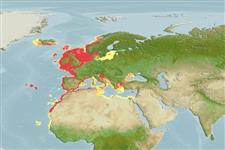>
Eupercaria/misc (Various families in series Eupercaria) >
Labridae (Wrasses)
Etymology: Labrus: Name from Latin 'labrum' for lip, rim or edge; referring to the big lips of the fishes of the genus (from Ovid and Pliny according to Petrus Artedi).
More on author: Linnaeus.
Environment: milieu / climate zone / depth range / distribution range
Ecologia
marinhas associadas(os) a recifes; não migratória; intervalo de profundidade 2 - 200 m (Ref. 5292), usually 40 - 80 m (Ref. 4742). Subtropical; 68°N - 12°N, 32°W - 34°E
Eastern Atlantic: Norway south to Senegal, Azores and Madeira. Also in the Mediterranean.
Comprimento de primeira maturação / Tamanho / Peso / Idade
Maturity: Lm 16.0 range ? - ? cm
Max length : 40.0 cm SL macho/indeterminado; (Ref. 3397); 30.0 cm TL (female); common length : 30.0 cm SL macho/indeterminado; (Ref. 4742); idade máx. registrada: 20 anos (Ref. 35388)
Adults are found in the algal zone of rocky shores (Ref. 35388). Usually solitary or in pairs with young. Females lay about 1,000 eggs in a nest of algae; the nest is guarded by the male (Ref. 35388). Feed mainly on crustaceans but also fishes and mollusks (Ref. 4742) and worms (Ref. 35388). Oviparous (Ref. 205).
Oviparous, distinct pairing during breeding (Ref. 205). Males build dish shaped nests and guard the eggs (Ref. 205). Sex reversal is completed in 7 months (Ref. 34185, 34259).
Quignard, J.-P. and A. Pras, 1986. Labridae. p. 919-942. In P.J.P. Whitehead, M.-L. Bauchot, J.-C. Hureau, J. Nielsen and E. Tortonese (eds.) Fishes of the north-eastern Atlantic and the Mediterranean. UNESCO, Paris. Vol. 2. (Ref. 4742)
Status na Lista Vermelha da UICN (Ref. 130435: Version 2024-2)
Ameaça para os humanos
Harmless
Uso pelos humanos
Pescarias: pesca de subsistência; peixe esportivo: sim; Aquário: Aquários públicos
Ferramentas
Relatórios especiais
Baixar XML
Fontes da internet
Estimates based on models
Preferred temperature (Ref.
123201): 7 - 17.1, mean 10 °C (based on 279 cells).
Índice de diversidade filogenética (Ref.
82804): PD
50 = 0.5625 [Uniqueness, from 0.5 = low to 2.0 = high].
Bayesian length-weight: a=0.00871 (0.00516 - 0.01470), b=3.10 (2.95 - 3.25), in cm total length, based on LWR estimates for this species & (Sub)family-body (Ref.
93245).
Nível Trófico (Ref.
69278): 3.9 ±0.62 se; based on food items.
Generation time: 8.3 ( na - na) years. Estimated as median ln(3)/K based on 1
growth studies.
Resiliência (Ref.
120179): Baixo, tempo mínimo de duplicação da população 4,5 - 14 anos (K=0.13; tmax=17; tm=2; Fec=1,000).
Fishing Vulnerability (Ref.
59153): High vulnerability (58 of 100).
Nutrients (Ref.
124155): Calcium = 21.7 [10.4, 46.2] mg/100g; Iron = 0.475 [0.255, 0.932] mg/100g; Protein = 19.1 [16.3, 21.4] %; Omega3 = 0.238 [0.134, 0.411] g/100g; Selenium = 18.1 [8.8, 37.2] μg/100g; VitaminA = 81.7 [22.4, 355.0] μg/100g; Zinc = 0.868 [0.558, 1.412] mg/100g (wet weight);
